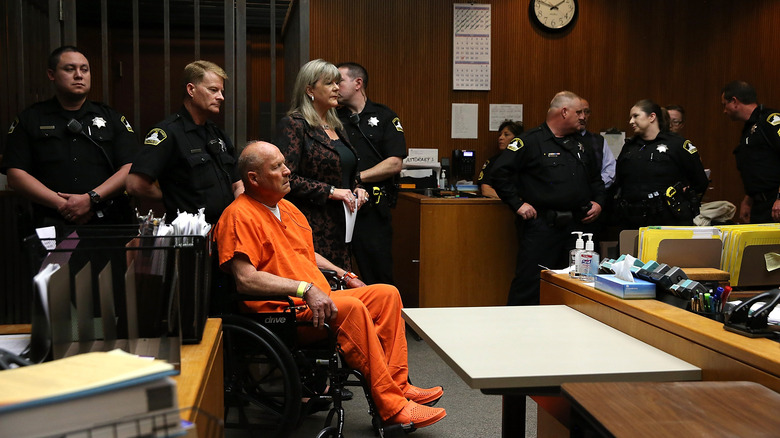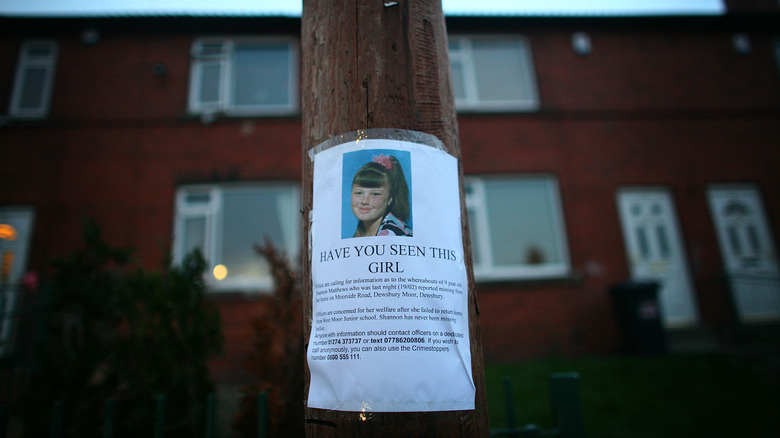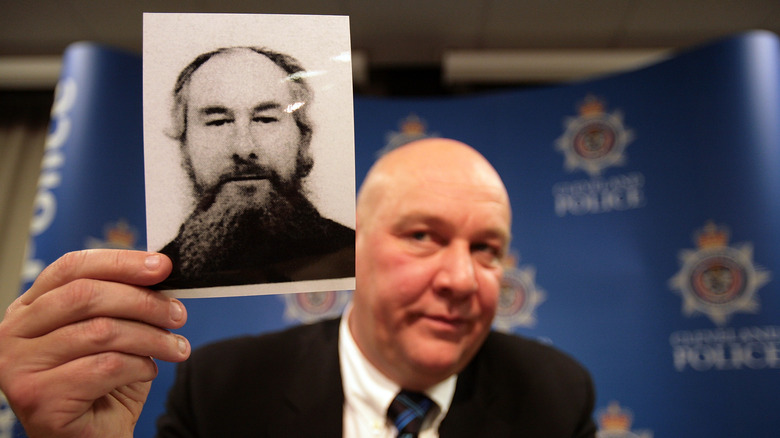The Biggest Plot Twists In True Crime Cases
In the age of streaming, true crime stories captivate audiences more than ever. And as The Ringer notes, tales of true crime fascinate millions of viewers who — we are repeatedly told — lack the attention spans of previous generations thanks to the sheer wealth of entertainment on offer.
So what is it about modern true crime shows that allows them to keep viewers enthralled time and time again? Rarely can they be described as uplifting, and given that they showcase humanity's darkest and most depraved aspects, surely we would tire of them eventually? But as audiences have been shown time and time again, sometimes fact is stranger than fiction, with many true crime stories containing unlikely twists and turns so outrageous they seem like wild feats of imagination — with the added intrigue from the fact that these events actually happened.
Here are some of the most unexpected twists in true crime history. And just in case you hadn't guessed already, this article contains countless spoilers for many true crime documentaries.
The Golden State Killer is finally caught
The Golden State Killer was one of the most notorious serial killers in American history, a murderer and serial rapist whose crimes spanned 11 Californian counties over the course of the 1970s and 1980s, according to The Guardian.
The crime spree began in 1976 with a series of over 40 rapes over the course of three years. The media dubbed the unknown assailant the East Area Rapist (via Biography), and it later emerged that the same killer had also shot and killed a couple walking their dog in Sacramento County in 1977. Then, between 1979 and 1986, south Californians were terrorized by a spate of brutal murders in which 10 people were killed, the majority of whom were heterosexual couples. Per the same source, it was only in 2001 that DNA evidence linked the earlier sexual assaults to these later sexualized serial killings, and the scale of the crimes committed by the elusive figure now known as the Golden State Killer came to light.
After so many years had passed, most who were following the case believed that the chance to apprehend the serial killer was lost. However, in 2018, news outlets shared the news that the Golden State Killer had finally been arrested, and his name was Joseph James DeAngelo, a U.S. Navy veteran in his early 70s who had previously worked as a cop.
In 2020, DeAngelo pleaded guilty to multiple charges, including 13 murders and 13 kidnappings.
If you or anyone you know has been a victim of sexual assault, help is available. Visit the Rape, Abuse & Incest National Network website or contact RAINN's National Helpline at 1-800-656-HOPE (4673).
Sally Clark's miscarriage of justice
In November 1999, Sally Clark, a solicitor and mother in her mid-30s, became a tabloid figure of hate in her native U.K. when she was found guilty of the murder of two of her three children, both of whom were infants at the time of their deaths (via The Guardian).
Clark claimed that both infants had died as a result of what is commonly referred to as "cot death." However, in court, Clark was accused of smothering her son, 11-week-old Christopher, in December 1996 and of shaking to death her eight-week-old son Harry 14 months later. One expert witness at the trial, Professor Sir Roy Meadow, gave decisive testimony that the chances of two similar cot deaths were "one in 73 million," resulting in Clark being convicted of double murder (via The Guardian). She was given two life sentences.
Clark appealed against her conviction the following year, but her efforts failed. It was only in 2003 that she was finally freed from prison, with experts revealing that Meadow's figures were inflated and bogus. John Batt, a member of Clark's defense team, said (per The Guardian): "Imagine being in jail where everyone thinks you are the scum of the earth, the lowest human being that walks the earth. The thick end of it is that she lost five to six years of her life in what was state-sponsored torture."
Compounding the serial tragedies that beset her life, Clark died of alcohol poisoning in 2007 at the age of 42.
The Murder of Sherri Rasmussen
Sherri Rasmussen was a young, married nurse of some repute. Only in her late 20s, her expertise was already such that she lectured widely in her chosen field, was director of the Glendale Adventist Medical Center in Los Angeles, and was highly regarded by her friends and colleagues, according to Vanity Fair.
On February 24, 1986, Rasmussen's body was discovered by her husband, John Ruetten, at their home in Van Nuys. She had been shot three times and badly beaten, evidence that a violent struggle had taken place before she was murdered. After a preliminary investigation, homicide detective Lyle Mayer told Ruetten that his home had been "burglarized" and that Rasmussen must have stumbled upon the intruders while they were in the process of emptying the house of valuable electronic equipment, leading to the confrontation. Distraught at the loss of Rasmussen, Ruetten quit his job and moved away from Los Angeles. With no evidence emerging from Rasmussen's stolen BMW, the case went cold. It would remain that way for 23 years.
Per the same source, in 2009, Los Angeles police interviewed Stephanie Lazarus (pictured), an officer who had first joined the force in 1983. Lazarus was an old girlfriend of Ruetten's and had taken exception to his marrying Rasmussen. It was finally revealed that Lazarus had murdered Rasmussen out of jealously after harassing the newlywed couple for months and made efforts to stage the murder as the scene of a burglary gone wrong. In 2012, Lazarus was sentenced to 27 years to life in prison.
The Kidnapping of Steven Stayner
Steven Stayner was just 7 years old when he disappeared not far from his home in Merced, California, on December 4, 1972. As the years rolled on, it appeared he had vanished without a trace — yet another child gone missing, never to be found. However, in February 1980, Stayner miraculously returned to the world after appearing at a police station in Ukiah, dragging 5-year-old Timmy White with him (via the Los Angeles Times).
Stayner told officers that he had been abducted by Kenneth Parnell, a predatory pedophile who had previously been incarcerated in San Quentin Prison for molesting a child in the early 1950s. Parnell renamed Stayner "Dennis Parnell," posing as the boy's father and moving with the child throughout the region as he systematically abused Stayner over the course of seven years, subduing the boy with drugs and alcohol.
According to the Lodi-News Sentinel, Stayner lived what looked like a normal life with Parnell, attending school and playing sports with other kids. He had plenty of opportunities to escape but was told by Parnell that his family could no longer care for him and that Parnell had been awarded custody over him. It was only when the Parnell abducted White — whose despair affected Stayner deeply — that the elder victim finally chose to escape.
Stayner died in a motorcycle accident on September 16, 1989, aged 24. Timmy White, then age 14, attended Stayner's funeral with his parents.
Jussie Smollett's faked assault
Jussie Smollett's career had hit a peak by 2019. The star of the hit show "Empire" — which had by then run for five successful seasons on Fox and attracted a loyal audience of tens of millions — saw him established as a Black queer icon. However, fans were shocked when it was reported that the actor had been the target of a violent racist and homophobic assault at the hands of two men who doused the actor in bleach and hung a noose around his neck, per NPR.
As Rolling Stone's Ernest Owens notes, hate crimes were on the rise at the tail end of the 2010s, with an escalating culture war taking hold as the 2019 presidential elections approached. Smollett's story seemed emblematic of the increasingly violent milieu into which America had sunk, while his celebrity ensured that the attack became a headline story. But all was not as it first appeared. Smollett was later arrested for filing a false police report, with evidence emerging that he had hired two men to stage the attack as a cynical publicity stunt.
Owens argues that frustrations within Smollett's career — a failure to build a following as a musician, as well as the lack of additional roles outside of "Empire" — may have contributed to his hatching his ill-advised publicity stunt. Smollett was sentenced to 150 days in jail and given a fine of $145,000 for lying to the police, according to the BBC.
The Phantom of Heilbronn
In the 1990s and 2000s, police in several countries reached the terrifying conclusion that a mysterious, violent criminal — a phantom — was stalking Europe.
According to the BBC, investigators were alarmed when it was discovered that the same DNA — that of an unknown woman — had appeared at more than 30 crime scenes in Germany and Austria. Her crimes included the killing by strangulation of an elderly victim and the murder of a 22-year-old female police officer in the German city of Heilbronn. It was believed that the Phantom of Heilbronn may have been responsible for a total of six killings over the course of 16 years. The possible identity of the phantom — who had previously been dubbed the "woman without a face" in several reports — became a source of some confusion in 2008 when German police released a photofit of a bearded young man, leading the BBC to ask: "So is the Phantom of Heilbronn a man or a transsexual?" Investigator Rainer Koeller said: "We can't rule out that our suspect is a man now — or that she looks like a man. We just don't know," per the same source.
However, the following year, police were forced to admit the phantom had never existed after the DNA found at the crime scenes was traced back to a woman working at the plant where forensic swabs were manufactured, and the whole thing had been a strange case of forensic contamination.
The death of Azaria Chamberlain
As far as 1980s catchphrases go, "a dingo ate my baby!" is among the darkest — though many of us today may not be aware of the tragic backstory that gave birth to the phrase. In August 1980, Michael and Lindy Chamberlain were a young Australian couple enjoying a vacation at a campsite near the imposing Uluru, aka Ayers Rock. They had with them their three children: young sons Aiden and Raegan, and their baby daughter Azaria (via National Museum Australia).
One evening after a day's hiking, Lindy put her two youngest children to bed in the family tent. She later went to check on them after mingling with other campers at the site when her famous cry rang out. According to Snopes, the area around Uluru was searched extensively, but Azaria's body was never found, nor was there seemingly any evidence that Lindy's story was true. In 1981, Lindy herself was sentenced to life in prison for the murder of her own daughter, with Michael also being found guilty as an accessory after the fact.
Lindy was imprisoned until 1986 when a chance discovery finally revealed that she had been the victim of a miscarriage of justice. Per Snopes, a British backpacker had fallen and died on Uluru, and during the search to find him, investigators uncovered a baby's jacket that was buried in the dust just a few feet from a dingo habitat. The couple was officially exonerated of any wrongdoing in 1988.
The kidnapping of Shannon Matthews
In February 2008, a headline in the British press made residents of the U.K. experience an uncomfortable sense of deja vu. Shannon Matthews, a 9-year-old girl from the county of West Yorkshire, had reportedly gone missing on February 19 while walking home from school, resulting in what the BBC describes as a "huge" police search and a public appeal on behalf of Matthews' family. At the time, many commentators compared the disappearance to that of Madeleine McCann, the toddler who was reportedly taken during the night from her parents' vocational rental on the island of Praia da Luz, Portugal, in May the previous year.
However, the nation was shocked the following month when investigators discovered Shannon alive and well at the home of 40-year-old Michael Donovan, the uncle of Craig Meehan, the partner of Shannon's mother, Karen. It transpired that Shannon's disappearance was orchestrated by members of her own family — including Karen — with the hope of arranging her reappearance in a way so that the conspirators might claim tens of thousands of pounds (dollars) in reward money from British newspapers. Both Karen Matthews and Michael Donovan were given jail sentences for the scheme, which the presiding judge describes as a "wicked and evil crime," per the BBC.
John Leonard Orr
John Leonard Orr was one of the most respected arson investigators in the Glendale Department. According to Newsweek, he had a knack for sensing when a fire had broken out and responding with incredible speed. He also had an uncanny ability to tell an arson attack from a fire that had started purely by accident. In October 1984, a fire broke out at a South Pasadena hardware store and took the lives of four people, including a 2-year-old child. According to the True Crime Database, numerous investigators were called to the scene, and all except Orr agreed that the blaze had been caused by faulty electrics. But Orr insisted that it was the work of an arsonist, identifying the fire's "point of origin."
It was only when fingerprint technology improved in the early 1990s that it was revealed Orr himself had been responsible for the fire — and more than 2,000 other fires between 1984 and 1991, according to Newsweek. One piece of evidence used in Orr's trial was a novel Orr himself had written called "Points of Origin," which tells the tale of a fire officer who, like him, is also a secret arsonist. Creepily, the character in the novel sets fires to achieve a sexual thrill.
Canoe man
One of the weirdest cons in British history came to light in 2007 after John Darwin — a married father of two adult sons — turned himself in to a London police station claiming (via The Guardian): "I think I am a missing person."
To the wider world, Darwin had been missing and presumed dead for five and a half years by the time of his miraculous reappearance, having last been seen paddling into the brutally cold North Sea in March 2002 in a homemade canoe. Coroners in 2003 issued a death certificate, assuming that Darwin had "probably encountered difficulties" at sea that overwhelmed his vessel (per The Guardian). Darwin claimed to have had amnesia, and his recollections of the intervening years were vague.
But Darwin's story fell apart when, shortly after his reappearance, a photo emerged of him beside his wife, Anne, in the office of a real estate agent in Panama, which was dated 2006. Anne had been aware of her husband's whereabouts the whole time and cashed in on his generous life insurance policies, redirecting the funds to property overseas with his help. The whole time, their children had no idea that their father was still alive.
The couple's son, Mark, recalled the moment he was told his father was missing (via Teesside Live): "I traveled to Hartlepool, and my mother was at home when I got there. She flung her arms around me, and she said, 'He's gone, I think I've lost him,' and wouldn't stop crying for ages. It crushed my world."
John and Anne Darwin were sentenced to over six years in prison for fraud.
Robert Durst's surprise confession
Millionaire and heir to the Durst real estate fortune Robert Durst became one of the world's most notorious and visible suspected murders after the release of "The Jinx: The Life and Deaths of Robert Durst," a 2015 HBO documentary series made with Durst's involvement that investigated a string of brutal killings to which he was connected.
By the time of the documentary's release, Durst had been suspected of killing three people (per Rolling Stone) — his wife Kathleen, who mysteriously disappeared in 1982; his friend and confidante Susan Berman, who was found dead in her home in 2000; and his neighbor, Morris Black, whose dismembered body was found in Galveston Bay. Though Durst had admitted to the killing and dismembering of Black in court, he was acquitted by the jury, which deemed he had acted in self-defense.
It seemed that Durst was just one of those slippery characters who would never be held accountable for the crimes he seemed likely to have committed. That was until the final interview of "The Jinx," in which Durst, forgetting that he is still wearing a microphone during an off-camera bathroom break, inadvertently confesses to the murders with the phrase: "killed them all, of course." According to BuzzFeed, the audio was used in court during his 2021 trial, and he was finally convicted of the murder of Susan Berman. Durst was sentenced to life in jail but died shortly afterward.
Dolly Oesterreich's secret lover
The majority of true crime stories circulating today have happened in the last 50 years or so, with many dealing with events of the not-so-distant past. In contrast, the story of Walburga "Dolly" Oesterreich is over a century old at this point, but that doesn't stop it from being one of the most jaw-dropping cases you're likely to encounter.
Oesterreich was the wife of a wealthy Milwaukee businessman, Fred, who had taken Dolly, a former factory worker, and turned her into a homemaker. In 1913, after several years of marriage, she began an affair with a 17-year-old named Otto Sanhuber, a repairman who often worked at Fred's factory, according to Milwaukee Magazine. Fred eventually discovered his wife's infidelity, though he was convinced by his wife's promise that she would break things off with the teenager.
Years passed, and Dolly and Fred eventually moved to Los Angeles for the sake of a new factory. However, in August 1922, Fred was found dead from a gunshot in his home, while Dolly was locked in a cupboard, shaken but safe. It appeared as though Fred had been murdered by intruders, but police were baffled that no valuables had been taken from the house. Although it was never ascertained who pulled the trigger that night, it eventually came to light that Dolly's lover Otto was still on the scene, having lived secretly for almost a decade in the attic of the Oesterreich's Milwaukee and Los Angeles homes, only emerging when Fred was at work to spend time with Dolly. It was believed that Otto shot Fred after becoming convinced he would hurt Dolly during a heated argument.
The framing of Russ Faria
When Troy, Missouri, resident Russ Faria called police to report that he had found his wife, Betsy, stabbed to death in their own home on December 27, 2011, he immediately became the prime suspect.
Per The New York Post, Faria was interviewed by police for a full day after he called the murder in, and though he had a strong alibi to account for his movements at the time of the murder — he had been visiting friends for a movie night — he was charged with the killing. At his trial, Betsy's friend, Pam Hupp, described how Betsy had been scared of her husband and painted him as a dangerous figure capable of killing his wife (via St. Louis Magazine).
But as many in Faria's defense team suspected, Hupp herself was responsible. Testifying that she had been made the beneficiary of Betsy's life instance policy just days before the murder, Hupp was now framing Faria for the death. Faria served two years in prison as a result before he was freed on appeal, while Hupp went on to kill again, shooting a man whom she claimed was sent by Faria to kill her. She has since been charged with murder for both killings.
The return of Delimar Vera
It was just days before Christmas 1997, and in Philadelphia, Pennsylvania, mother Luz Cuevas had just welcomed her third child — a daughter named Delimar Vera — into the world when her family was struck by a horrifying tragedy.
Per CNN, on December 15, a blaze broke out at the family's two-story home, with the flames engulfing the bedroom where 10-day-old Delimar slept. Cuevas attempted to enter the burning building to save her baby but was unable to fight through the fire to get to her and was forced to flee the house. In the aftermath of the tragedy, responders searched for any sign of the child's remains but found nothing. It was assumed she had been entirely incinerated, the unfortunate victim of an electrical fire.
Years passed, until in January 2004, Cuevas was at a children's birthday party where she encountered a 6-year-old girl who bore an uncanny resemblance to herself and her surviving children. She managed to discreetly take a lock of the girl's hair, and upon having it tested, found that the girl was Delimar. She had been kidnapped by a local woman, Carolyn Correa, a woman Cuevas had met for the first time just hours before the fire. Per The Guardian, social services then began a "slow process" of reintroducing Delimar to her long-lost family.














